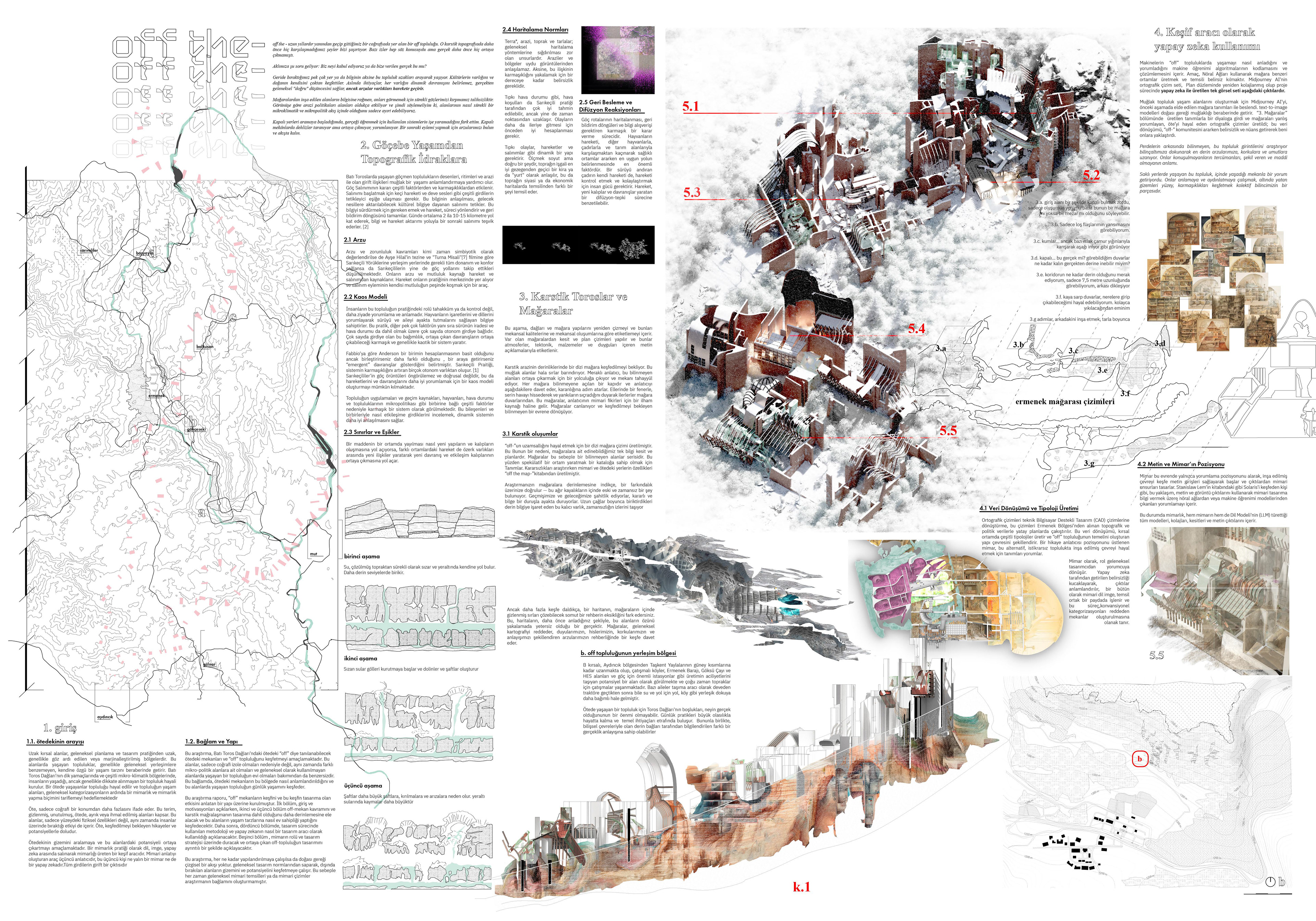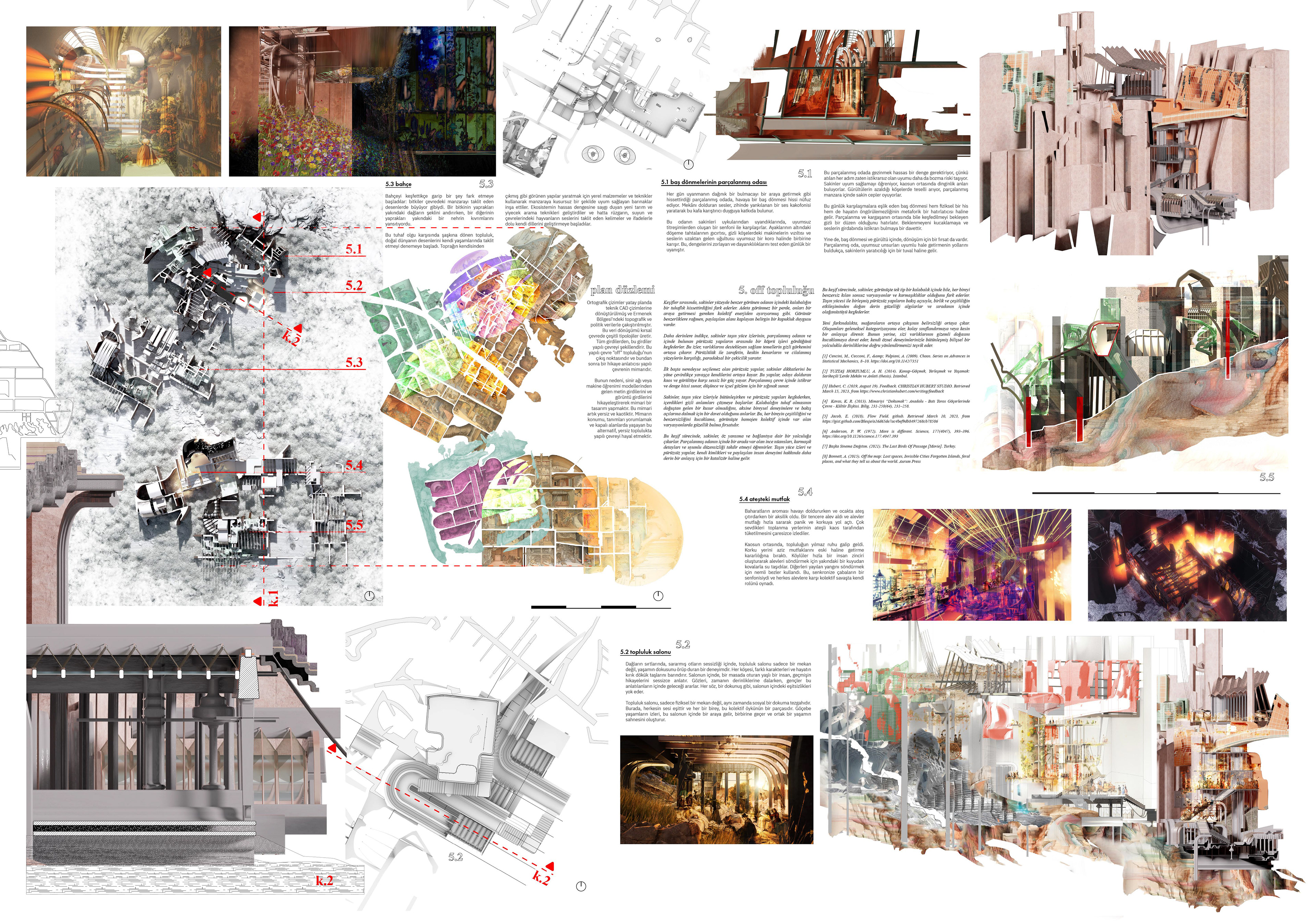In a land where the sun burns bright and the wind howls fiercely, there exists a community of interdependent and independent people. Their lives are not bound by the confines of walls and boundaries, but by the ever-changing landscape of their surroundings. They move, in sync with the language of nature.
Their way of life is a web of complexity that thrive in chaos, finding order in the disorder. Their movements seem haphazard and random, but they are guided by a collective knowledge allows them and their animals to be in the flow of their existence.
Their community is a model of chaos, a system that defies the conventional understanding of dwelling. Their home/homeland is a “karaçadır” and all the landscape that they are in with a constant state of flux. And yet, amidst all the disorder, there is a sense of unity of an oscillation, a bond that ties the interconnected complexity. Their knowledge is the way of life that holds the key to their very existence, movement.
off the - is an off community in a land we have been passing by for many years. It surprises that never encountered before in that karstic topography. Some traces always been in question but the truth was never revealed before.
Question raises: what do we acknowledge or is it the true reality what is given us?
Unlike many places or informations we left behind this community lives by searching the off. They already discovered the existance of the cultures and the nature itself. Indeed necessity doesn’t since dynamic behaviour of every entity provides what is really conventional thought of “right” yet desires drives the entities to move.
Although the information of the spaces built from the caverns it is unfortunate that we constantly blinked our eyes not to see them. Appereantly land politics quite affect the fields and now I have to say we can only distinct how their spaces constantly in a microclimatic and micropolitical flux.
As I started to look for the places of off, I realize that the systems to learn the truth is useless. In the off- the caverns are scanned, but not reveal it yet interpret it. Find our desires to make the next act, and stay in the flux.
Unlike many places or informations we left behind this community lives by searching the off. They already discovered the existance of the cultures and the nature itself. Indeed necessity doesn’t since dynamic behaviour of every entity provides what is really conventional thought of “right” yet desires drives the entities to move.
Although the information of the spaces built from the caverns it is unfortunate that we constantly blinked our eyes not to see them. Appereantly land politics quite affect the fields and now I have to say we can only distinct how their spaces constantly in a microclimatic and micropolitical flux.
As I started to look for the places of off, I realize that the systems to learn the truth is useless. In the off- the caverns are scanned, but not reveal it yet interpret it. Find our desires to make the next act, and stay in the flux.
Remote rural areas are often overlooked or marginalized areas, far from traditional planning and design practice. The communities living in these areas often bring with them a distinctive way of life that does not resemble traditional settlements. On the steep slopes and various micro-climatic zones of the Western Taurus Mountains, one imagines a community inhabited by people, but often ignored. A community of beyond dwellers is imagined, and the community's living spaces aim to describe a way of architecture and architectural practice beyond traditional categorizations. Beyond is more than just a geographical location. The term encompasses hidden, forgotten, beyond, discrete or neglected spaces. These spaces include not only the physical features on the surface, but also the impact they have on people. The beyond is full of stories and potentials waiting to be explored and aims to demystify the beyond and unlock the potential in these spaces. As an architectural practice, it is a tool of discovery that produces architecture by oscillating between language, image and artificial intelligence. The tool that creates the architectural narrative is the third narrator, this third person is neither a simple architect nor an artificial intelligence, but an intricate output of all inputs.
This research aims to explore the “off”-spaces beyond in the Western Taurus Mountains. These spaces are unique not only because of their geographical isolation, but also because they belong to different micro-political spaces and are home to a community living in traditionally unused spaces. In this context, it explores how off-spaces are made meaningful in this region and the daily life of the community living in these spaces. This research report is built on a structure that describes the exploration of off-spaces and its impact on the design. The first section explains the introduction and motivations, while the second section delves deeper into the concept of off-spaces and explores how these spaces host lifestyles. Then, the third chapter will explain the methodology used in the design process and how artificial intelligence is used as a design tool. The fourth chapter will elaborate on the role of the architect and the design strategy, and the fifth and final chapter will detail the design of the emerging off-community.This research, although structured, is not linear in nature, deviating from traditional design norms to explore the mystery and potential of excluded spaces. For this reason, traditional architectural representations or architectural drawings have not always formed the context of the research.
It involves the coding and decoding of machine learning algorithms how machines understand and interpret living in “off” communities. The goal is to generate cave-like environments using Neural Networks and to make the representation ambiguous. Midjourney AI's orthographic drawing set was generated as a “misinterpretation of caves” with inputs from the cave descriptions in the second phase. To generate the ambiguous community habitats, we fed Midjourney AI with the cave descriptions obtained in the previous phase. text-to-image models are inherently ambiguous. It entered into a dialog with the descriptions produced in “Caves” and produced orthographic drawings that misinterpreted the caves, imagining the beyond; this data transformation brought ambiguity and nuance as I searched for the “off-” community, bringing me closer to them. Behind the curtains, the unknown explores these community recesses, tapping into our subconscious, reaching out to our deepest desires, fears and hopes. They are the interpreters of the unspoken, the shapers of form and the meaning of the immaterial. Living in hidden places, this community interprets the space they inhabit. It is part of our collective consciousness to explore the complexities, to surface the underlying mysteries, to try to understand and illuminate them. Through their interactions with the world indoors, they reveal deep insights into the human condition.
Converting orthographic drawings into technical Computer Aided Design (CAD) drawings, comparing these drawings on horizontal plans with topographic and political data from the Ermenek Region. This data transformation generates various typologies in the rural setting and shapes the built environment that forms the basis of the “off community”. Assuming the position of a storyteller, the architect interprets the definitions to imagine the built environment in this alternative, unstable community.
Taking the position of the architect, I begin the exploration of the built environment by providing text inputs and design architectural elements from the outputs. Like the discoverer of Solaris in Stanislaw Lem's book, this approach involves using text and image outputs to interpret the output from neural networks or machine learning models to inform architectural design, in this case architecture includes all the models, collages, cutaways and text outputs derived by both the architect and the Language Model (LLM).
During the explorations, the inhabitants notice that the crowd inside the room, which looks similar on the surface, feels strange. It is as if an invisible curtain separates them from the collective energy that should bring them together. Despite the apparent similarities, there is a distinct sense of disconnection that pervades the shared space. As they delve deeper, the residents discover that the sublime traces of stone act as a bridge between the fragmented room and the smooth structures within. These traces reveal the hidden splendor of the solid foundations that support their existence. The contrast of roughness and elegance, sharp edges and polished surfaces, creates a paradoxical attraction: at first almost imperceptible, the smooth structures slowly reveal themselves as the inhabitants turn their attention in this direction. These structures radiate a quiet strength against the chaos and noise that fills the room. They offer a sense of stability and balance in the fragmented environment, a sanctuary for thought and introspection. As the inhabitants become one with the sublime traces of stone and explore the smooth structures, they begin to unravel the hidden meanings they contain. They realize that the strangeness of the crowd is not an inherent flaw, but rather an invitation to dive into individual experiences and perspectives. It is an opportunity to embrace the diversity and uniqueness of each individual, to find beauty in the variations that exist within the seemingly homogeneous collective.
In this process of discovery, residents embark on a journey of self-reflection and connection. They learn to appreciate the subtle nuances, intricate details and harmonious disorder that coexist within the fragmented room. The sublime traces of stone and smooth structures become a catalyst for a deeper understanding of their own identity and shared human experience. In this process of discovery, residents realize that even within a seemingly uniform crowd, there are infinite variations and complexities that make each individual unique. From the vantage point of the smooth structures merged with the sublime of stone, they perceive the profound beauty that arises from the interplay of unity and diversity, and discover the extraordinary in the ordinary.In the new awareness, the ambiguity of the emergence of the caves is revealed. Their occurrence defies conventional categorization, resisting easy classification or precise understanding. Instead, it invites you to embrace the mysterious nature of their existence, encouraging you to navigate their depths through a cognitive journey integrated with your own subjective experiences.
[1] Cencini, M., Cecconi, F., & Vulpiani, A. (2009). Chaos. Series on Advances in Statistical Mechanics, 8–10. https://doi.org/10.1142/7351
[2] TUZTAŞ HORZUMLU, A. H. (2014). Konup-Göçmek, Yerleşmek ve Yaşamak: Sarikeçi̇li̇’Lerde Mekân ve Anlati (thesis). Istanbul.
[3] Hubert, C. (2019, August 19). Feedback. CHRISTIAN HUBERT STUDIO. Retrieved March 15, 2023, from https://www.christianhubert.com/writing/feedback
[4] Kavas, K. R. (2013). Mimariyi “Dokumak”: Anadolu - Batı Toros Göçerlerinde Çevre - Kültür İlişkisi. Bilig, 231-258(64), 231–258.
[5] Jacob, E. (2018). Flow Field. github. Retrieved March 10, 2023, from https://gist.github.com/Bleuje/a16d65de7ac4bef9db8497268cb78586
[6] Anderson, P. W. (1972). More is different. Science, 177(4047), 393–396. https://doi.org/10.1126/science.177.4047.393
[7] Başka Sinema Dağıtım. (2021). The Last Birds Of Passage [Movie]. Turkey.
[8] Bonnett, A. (2015). Off the map: Lost spaces, Invisible Cities Forgotten Islands, feral places, and what they tell us about the world. Aurum Press

